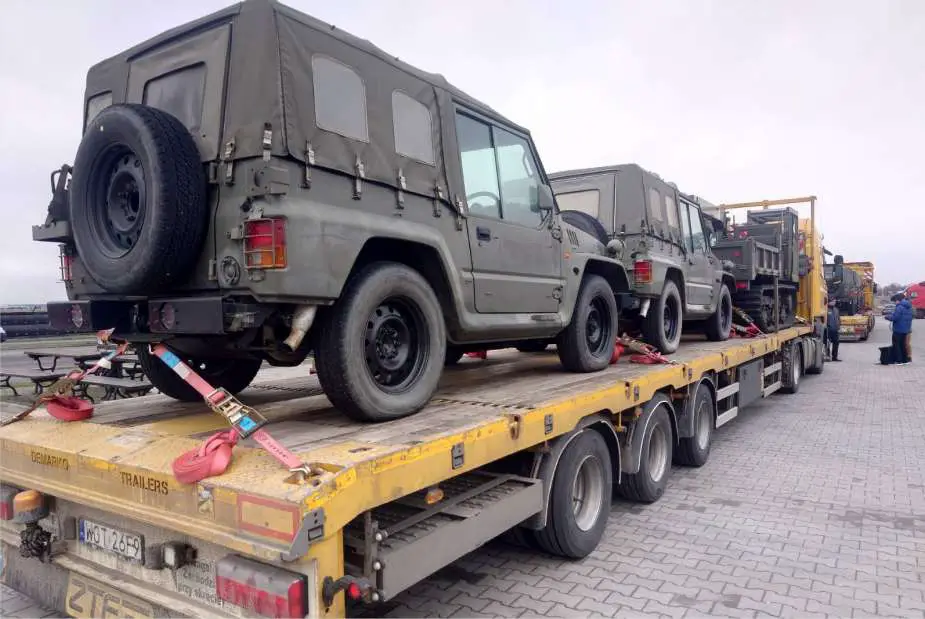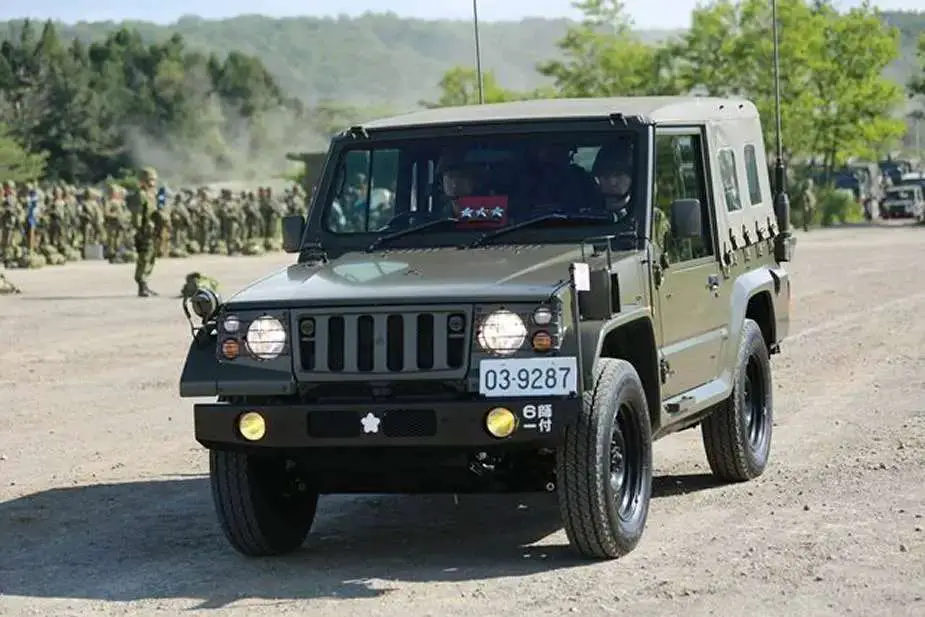Japan delivers Type 73 light tactical vehicles and Morooka tracked carrier to Ukraine
On December 26, 2023, the Embassy of Japan in Ukraine announced the delivery of military vehicles from the Ministry of Defense of Japan to Ukraine's Defense Forces. These vehicles comprise the second generation of Type 73 mid-size off-road vehicles and at least one Morooka tracked armored carrier.
Follow Army Recognition on Google News at this link

This delivery of military vehicles by Japan to Ukraine includes several Mitsubishi Type 73 light 4x4 vehicles and at least one Morooka tracked carrier. (Picture source: Twitter/JPEmbUA)
The Mitsubishi Type 73 Light Truck, officially designated as 1/2t Truck, has been utilized by Japan's Self-Defense Forces (JSDF) since its adoption in 1973. Manufactured by Mitsubishi Motors, this general-purpose light vehicle has undergone several iterations. The first generation, which includes the J-23A, J-24A, and J-25A types, was produced between 1973 and 1997 and was based on a licensed-built Jeep CJ-3B.
In 1996, a new version of the Type 73 was introduced, based on the second-generation Mitsubishi Pajero, replacing the outdated Jeep type. This upgrade, including the V16B and V17B types, aimed to address the limitations of the older model, such as compliance with exhaust gas regulations and loading capacity. The rear end of the frame of the short wheelbase model was extended, resulting in increased loading capacity. This update led to the renaming of the vehicle, from "Type 73 Light Truck" to "1/2t Truck," signifying its loading capacity of 440kg.
One of the significant improvements in the newer model is the adoption of Super Select 4WD, providing enhanced off-road capabilities. The front wheels also transitioned from rigid to independent suspension, improving handling stability. The increased tire diameter contributes to higher ground clearance, particularly under the axle differential.
The Type 73 Light Truck is designed with adaptability in mind and has been utilized in various military functions, primarily focused on transporting personnel, supplies, and equipment. Its lightweight construction and compact structure make it well-suited for maneuvering challenging terrains, allowing it to perform effectively in various operational scenarios.
The vehicle offers several configurations to meet diverse mission requirements, including a personnel carrier, radio truck, maintenance vehicle, and ambulance. Typically, the personnel carrier variant accommodates a driver and co-driver in the front, with additional space in the rear for troops.
It's important to note that the Type 73 Light Truck is not intended for direct combat but rather serves essential logistical and support roles in military operations. The Type 73 Light Truck has also been deployed in international missions, with a bulletproof variant provided in Iraq. Although it is typically unarmed, it may occasionally be equipped with a machine gun for self-defense purposes.

In 1996, a new version of the Type 73 was introduced, based on the second-generation Mitsubishi Pajero, with an increased loading capacity. (Picture source: JSDF)
A notable feature of the Type 73 is its incorporation of civilian vehicle components, including two engines sourced from the Pajero: the 4M40 2.8L 4-cylinder turbo diesel engine (utilized from 1996 to 2013), with an output of 125hp, and the 4N15 2.4L 4-cylinder turbo diesel engine (employed from 2014 onwards), which delivers a maximum output of 179hp. The Type 73 has dimensions of 4.1 meters in length, 1.8 meters in width, and 1.97 meters in height, and it can reach a top speed of 135km/h.
The Type 73 is equipped with a pintle hook for towing, but its towing capacity is limited to a 1/4 ton trailer due to its small size and engine output. For carrying out various missions, it can be fitted with a range of weaponry, including machine guns and anti-tank missiles.
Inside, the basic model accommodates six people, with two passengers in the rear third seat facing each other. The remaining two passengers sit in the second seat at the rear of the front seats. For specialized communication-equipped vehicles, the second seat can be modified to accommodate radio equipment.
The Morooka was originally a civilian tracked carrier dump truck modified for military use by the Japan Ground Self-Defense Force, primarily for the local transportation of construction materials and heavy loads. Prior to its deployment, there was a lack of small specialized vehicles capable of efficiently transporting materials in challenging terrains, such as steep slopes and mountainous regions, where regular trucks struggled. Consequently, the Morooka, with its off-road capabilities, was introduced around 1990 to address this need.
The Morooka, in its PC-065B variant,, manufactured by the Morooka Corporation, has an overall length of approximately 4.3 meters, a width of about 2.15 meters, and a height of around 2.2 meters, with a weight of roughly 5 tons. The Morooka can carry a maximum payload of approximately 3 tons and has a lifting capacity of approximately 2 tons. Its top speed is around 20 km/h, and it can handle slopes with a gradability of up to 30 degrees. Additionally, it can traverse trenches up to approximately 1 meter in depth.
Under the hood, it features a 4.4-liter engine, with a rated output of 92.8 kW at 2,200 rpm and a maximum torque of 550 N·m at 1,400 rpm. The Morooka is transportable using large trucks.
In terms of equipment, it comes equipped with a crane with a lifting capacity of approximately 2 tons, positioned at the center of the vehicle, and a cargo bed with a maximum payload capacity of up to 3 tons, making it suitable for transporting soil, materials, and even ammunition. The vehicle accommodates a crew of two members and is manufactured by the Morooka Corporation.
The civilian version of the Morooka features an asymmetric (single-seat) cockpit. However, the military variant used by the Self-Defense Force has been adapted to accommodate two crew members, with seating on both sides. The steering mechanism remains on the left side, while the right side serves as a seating area for a crew member. Another feature of the Self-Defense Force version is the centrally positioned crane.
The Morooka's interior includes a T-shaped steering wheel and minimal instrumentation, with essential elements like a speedometer. The front of the cabin is fitted with glass windows, while the side doors are removable and made of fabric, with vinyl windows. This design simplifies entry and exit during loading and unloading operations.

The Morooka tracked carrier is primarily used for the local transportation of construction materials and heavy loads. (Picture source: JSDF)
- Hits: 6471
















